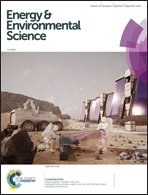A copper nickel mixed oxide hole selective layer for Au-free transparent cuprous oxide photocathodes†
Abstract
State-of-the-art cuprous oxide (Cu2O) photocathodes for photoelectrochemical (PEC) water splitting have a long tradition of using gold (Au)-coated F-doped SnO2 (FTO) substrates for the improvement of Cu2O electrodeposition and overall PEC performance. Au is one of the best contact materials for Cu2O photocathodes due to its large work function enabling proper alignment with the valence band level of Cu2O. Due to its relatively large band gap (2.0 eV), Cu2O is preferentially used as the top-cell absorber in tandem with a photoanode or a photovoltaic (PV) cell for overall solar-driven water splitting. However, the Au contact poses a major issue due to its poor transparency. Moreover, Au is a precious metal, which increases the cost and can hinder the scalability of PEC devices. In this work, we propose an effective replacement of the Au layer with a transparent and cost-efficient copper-nickel mixed oxide (CuO/NiO) thin film, which is prepared by a facile sequential sputtering deposition combined with an annealing process in air. We successfully demonstrate that a thin layer of the CuO/NiO film shows better transparency as well as well-aligned energy levels for efficient hole collection leading to an improved PEC performance compared to the performance of a Au-contact based equivalent device in a pH 5 electrolyte biased at 0 V versus the reversible hydrogen electrode. This new transparent and efficient CuO/NiO layer paves the way for the development of efficient, yet inexpensive PEC–PV or photocathode–photoanode stacked tandem devices for a hydrogen fuel based economy.



 Please wait while we load your content...
Please wait while we load your content...